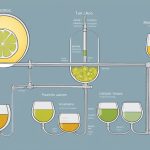Welcome to my personal guide comparing pale ale and lager! As a beer enthusiast, I have explored both styles extensively, and I am excited to share my insights with you. Whether you’re a beginner or a seasoned beer drinker looking to expand your horizons, this guide will help you understand the differences between pale ale and lager.
What is Pale Ale?
Pale ale is a beer style that originated in England. It is known for its pale golden to amber color and hop-forward flavor profile. Pale ales are typically brewed with a generous amount of hops, which give them a distinct bitterness and aroma. The hops used in pale ales can vary, but they often impart citrus, floral, or piney notes.
One of my favorite pale ales is the Sierra Nevada Pale Ale. It has a perfect balance of hop bitterness and malt sweetness, making it incredibly enjoyable to drink. The flavors of citrus and pine are prominent, making it a refreshing beer to have on a hot summer day.
What is Lager?
Lager, on the other hand, is a beer style that originated in Europe, particularly in Germany. Unlike pale ale, lager is known for its smooth and crisp taste. The word “lager” actually means “to store” in German, and this beer style is named so because it is traditionally brewed and aged at low temperatures.
One popular lager that I always recommend to beginners is the Pilsner Urquell. It has a light golden color and a clean, refreshing taste. The flavors of malt and hops are well-balanced, making it a great beer to pair with a variety of foods.
Differences in Brewing Process
The brewing process for pale ale and lager is one of the key factors that differentiate these two beer styles. Pale ale is typically brewed using top-fermenting yeast, which ferments at warmer temperatures. This results in a beer with more fruity and estery flavors.
In contrast, lager is brewed using bottom-fermenting yeast, which ferments at cooler temperatures. This extended fermentation period contributes to the smooth and clean taste of lagers. Additionally, lagers are often aged for a longer time, allowing the flavors to mellow and develop.
Flavor Profiles
When it comes to flavor, pale ales are known for their bold hop bitterness and citrusy or floral hop flavors. They often have a malty backbone that balances out the hops, creating a well-rounded taste. The bitterness of pale ales can vary, with some being more intense than others.
On the other hand, lagers have a milder hop presence, with a focus on the smoothness and crispness of the beer. Lagers tend to have less bitterness and more subtle flavors, such as bread or biscuit notes from the malt. The overall taste of a lager is refreshing and clean, making it a popular choice for easy-drinking.
Food Pairing
Both pale ales and lagers pair well with a variety of foods, but the choice of pairing can vary depending on the flavor profile of the beer. Pale ales, with their hop-forward nature, go well with spicy foods, grilled meats, and strong cheeses. The hop bitterness can cut through the richness of these dishes and enhance the overall flavors.
Lagers, with their clean and crisp taste, are versatile when it comes to food pairing. They complement lighter dishes such as seafood, salads, and grilled vegetables. The subtle malt flavors in lagers can enhance the flavors of these dishes without overpowering them.
Conclusion
Exploring the world of beer is an exciting journey, and pale ale and lager are two fantastic styles to start with. Whether you prefer the bold hop bitterness of a pale ale or the smooth and crisp taste of a lager, both styles offer unique flavors and experiences.
Remember, taste is subjective, and everyone has their own preferences. I encourage you to try both pale ale and lager and see which style resonates with you the most. Cheers to discovering new beers and expanding your palate!







